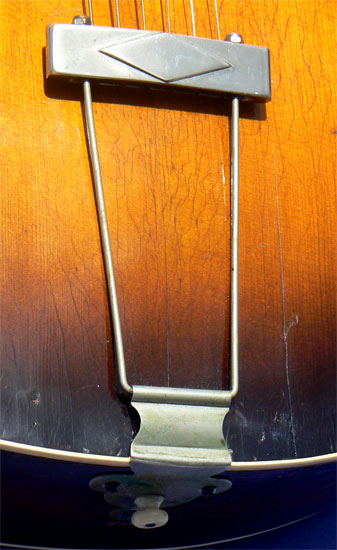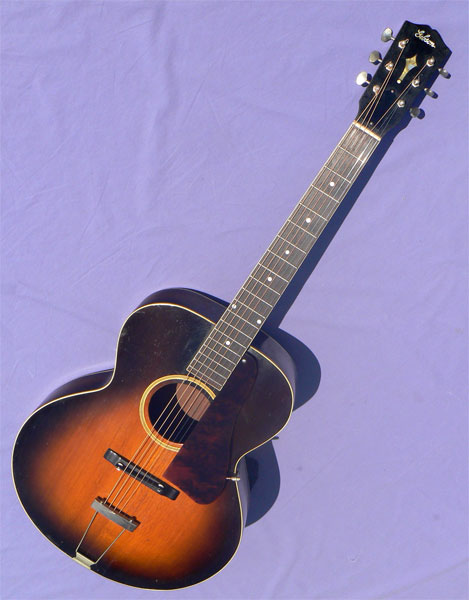 c.1937 Gibson L-75
c.1937 Gibson L-75 Home / Instruments /Accessories / Ordering / Tips / Friends
archtop.com
 c.1937 Gibson L-75
c.1937 Gibson L-75
Status: For pricing and hold status for this instrument, please check our Instruments page here. If this instrument does not appear on the Instruments page it has been sold, and is no longer available. Photos and descriptions of Previously Sold instruments may by found here. To be notified of examples of this or any other model in the future, please contact [email protected].
FON #: 168 (C), stamped on neck block. Body size at lower bout: 16". Scale length: 24 3/4" Nut Width: 1 3/4" Neck depth, 1st/10th frets: .91/1.03
Materials: Solid carved spruce soundboard; solid mahogany back, sides, and neck; bound solid ebony fingerboard.
Hardware: Original hardware includes compensated ebony bridge and raised-diamond trapeze tailpiece. Vintage correct hardware includes contoured tortoise pickguard, Waverly aged nickel Sta-Tite open back tuners. Original tuners included in the case.
Notes: It's the oldest adage in the music business: 'The more they're played, the better they sound."
One of Gibson's rarest archtop models, the elusive L-75 went through a different permutation in each of its first four years of production. Debuting in 1932, the L-75 premiered with a 14 3/4" flat-backed maple body. By the following year, the body had been converted to mahogany, and fitted with a fanciful pearloid neck, ala Gibson's Century of Progress flat top. The next model year, the body was elongated, and the neck fitted with a dot inlay fingerboard. And finally, after no fewer than three different designs, this ever-mutable model assumed its final form in 1935, with a 14 fret 16" body, identical in dimensions to Gibson's L-4, which was redesigned as an f-hole archtop that same year.
Though functionally similar to the round hole L-4, the L-75 was fitted with a solid carved back and sides of Honduran mahogany, making it unique among Gibson prewar archtops. This made it one of the lightest models of its size ever produced, and lends the voice an appealing warmth and clarity. And alone among Gibson branded archtops, the L-75 was finished with a distinctive lateral sunburst on the sides, a pattern more typically seen on Gibson's OEM models for other brands.
This veteran example weighs in at an featherweight 4lb 5oz, surely one of the lightest instruments of its size we've ever played. With its formally shaded dark Cremona sunburst over a hand graduated solid spruce top, this bandstand warrior has the clear, open voice of tonewood aged for almost a century, and played vigorously for many decades. The classic V neck is worn smooth with honest thumbwear, and the finish is weathered a bit on the back and sides near the neck heel, from years of play. Though the top shows the typical scattered checking of a vintage finish, it shows very little pickwear, a sign of a careful longtime player.
A short hairline crack near the tailpiece has been soundly cleated and resealed long ago, and the instrument has been fitted with a vintage correct tortoise pickguard fashioned from an original template. A smooth and costly set of relic nickel prewar style Waverly tuners is installed as well, with the original tuners included in the case, along with an additional ebony Fishman piezo bridge with 1/4" jack.
The neck is comfortable, with a traditional V profile, and the action is smooth and low over a solid ebony fingerboard with fine pro fretwork, and a fresh high precision setup. The top is carved and braced very lightly, with a clear voice both throaty and transparent. The guitar simply thunders in the bass register, with an extremely 'wet' natural reverb in the treble range as well. With the superior projection of the arched soundboard, the warmth of the mahogany body, and the powerful bass and sustain of the round hole design, this guitar is an extremely versatile instrument, suitable for a wide variety of musical styles. It's the wide open tone of a well loved instrument that has delighted audiences for a lifetime.
Though Gruhn lists the L-75 as produced through 1939, there is no trace of this scarce model in any Gibson catalog after 1936, the year before this exceptional example rolled off the line. It's only the second one we've found in three decades, and given how rarely this Depression Era guitar is seen in the vintage market, there can be little doubt of the model's scarcity. A remarkable find, and one true cannon of a guitar. One only: call now.
Setup: Trussrod tension and neck relief adjusted; bridge height adjusted; bridge compensation set; string slots at nut and bridge inspected and recut as necessary; bridge foot contour inspected and fit to top as necessary; bridge radius inspected and recurved as necessary; bridge wheels and tuners lubricated; fingerboard and bridge conditioned; body and neck cleaned and hand polished.
Case: Older deluxe black plush lined hardshell case.
.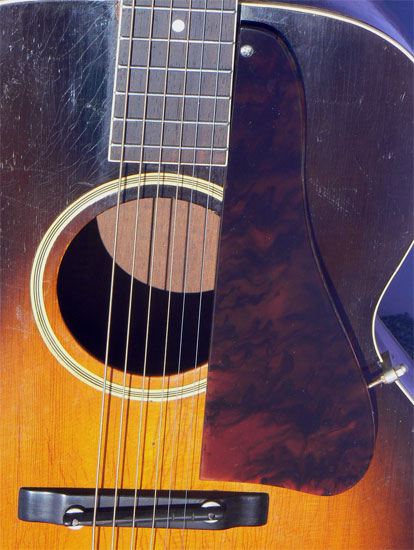
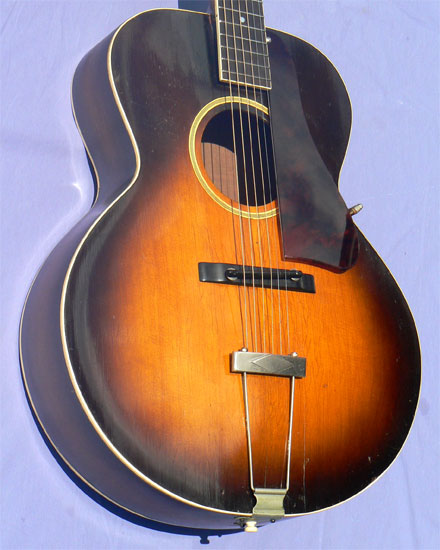
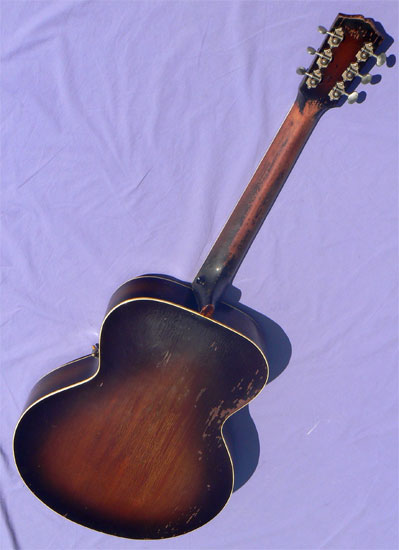
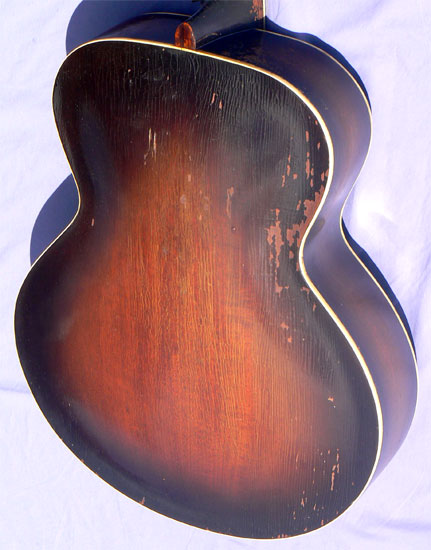
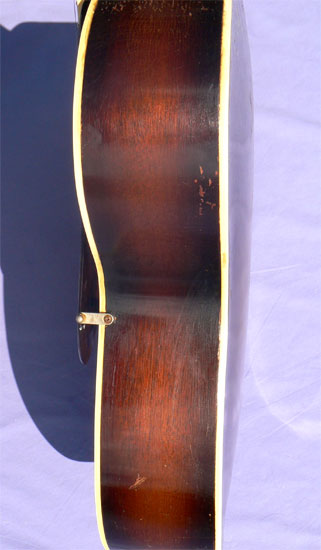
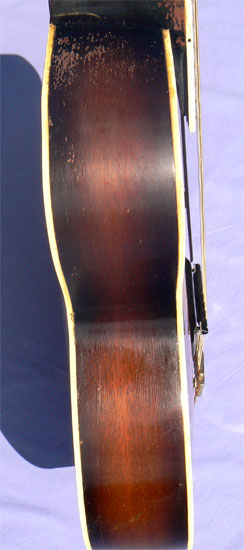
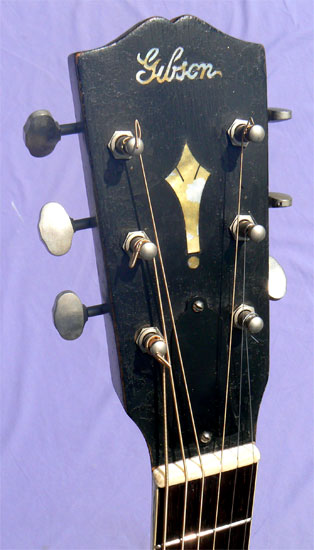 Home / Instruments /Accessories
/ Ordering / Tips / Friends
Home / Instruments /Accessories
/ Ordering / Tips / Friends 